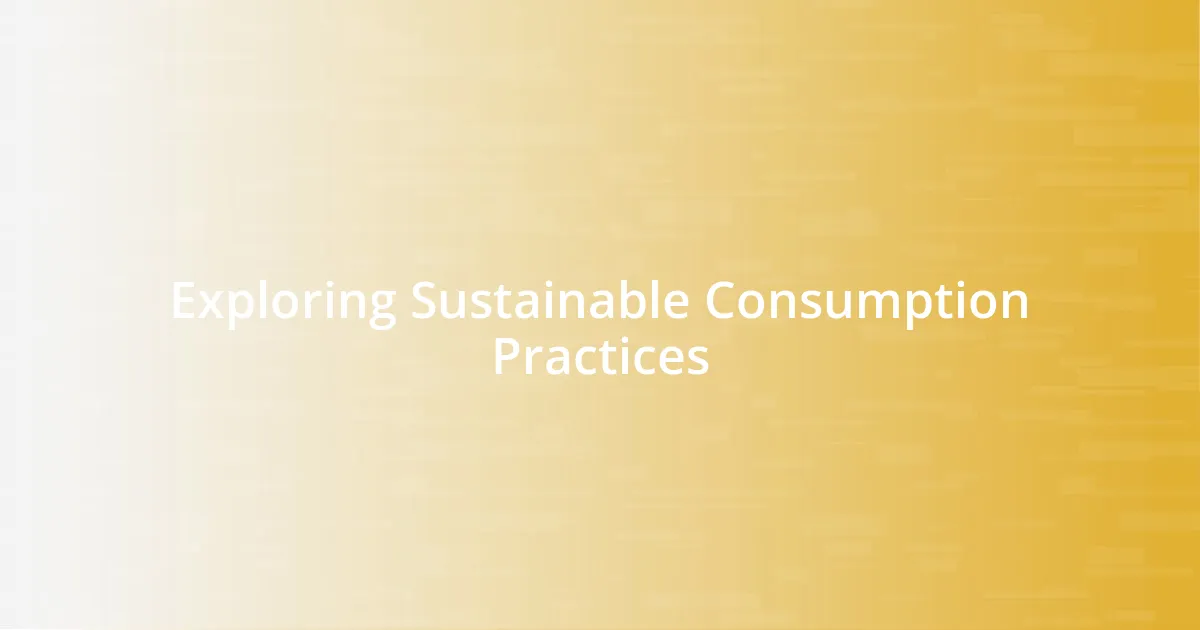Key takeaways:
- Recognized the emotional triggers behind consumption choices, leading to more mindful purchasing habits.
- Explored sustainable practices, such as reducing plastic waste and supporting local farmers, enhancing personal connection to consumption choices.
- Implemented budgeting techniques and minimalist living, emphasizing experiences over material possessions for greater fulfillment.
- Engaged in sharing knowledge and experiences with others, fostering a community and encouraging collective reflection on consumption habits.

Understanding Consumption Basics
Consumption, at its core, is the process of using goods and services to satisfy our needs and desires. It’s fascinating to think about how my own habits shaped over time—like when I realized that mindless shopping often filled a void rather than addressed a real need. Have you ever found yourself buying something just because it was on sale, only to leave it unopened in the back of your closet?
When I began to understand the basics of consumption, I uncovered the emotional triggers behind my decisions. I remember one particular shopping trip where I impulsively bought a bunch of items, only to feel a wave of guilt when I got home. Reflecting on this experience helped me recognize that consumption is not just about acquiring things; it’s deeply tied to our emotions and societal influences.
I’ve also learned that consumption can be categorized into various types—need-based versus want-based, for example. Have you thought about whether you’re consuming to fulfill a need or simply out of habit? This distinction really made me rethink how I approach purchases, leading to more mindful and satisfying decisions.

Identifying Personal Consumption Patterns
Identifying my own consumption patterns was an eye-opening journey. I began by keeping a journal of my purchases, noting not only what I bought but how I felt before and after each purchase. I can still vividly recall a time when I bought a trendy jacket during a late-night online shopping spree. The thrill faded quickly when I realized it didn’t even match my wardrobe. This reflection helped me appreciate how my mood often dictated my spending habits.
To understand these personal patterns better, I focused on a few key areas:
- Emotional Triggers: I recognized that stress often led me to shop for comfort, disguising genuine needs.
- Impulse Purchases: I noted when I made unplanned purchases and explored what prompted those decisions.
- Frequency of Purchases: Tracking how often I bought items, especially duplicates or things I didn’t need, highlighted my tendencies toward accumulation rather than use.
Each of these points has been instrumental in reshaping how I view my consumption, deepening my understanding of what I truly value.

Exploring Sustainable Consumption Practices
Exploring sustainable consumption practices is increasingly important, especially as we become more aware of our impact on the environment. When I first learned about the concept of “reduce, reuse, recycle,” it genuinely changed the way I approached my purchases. For example, I remember years ago, I bought disposable water bottles every week for convenience. Eventually, I switched to a reusable bottle, not only saving money but also reducing plastic waste. Have you tried switching to reusable products? If you haven’t already, I highly recommend it.
Diving deeper into sustainable practices, I started to evaluate the lifecycle of products. Understanding where items come from and how they’re made is vital. One striking moment for me was learning about fast fashion. I recently watched a documentary on the environmental destruction caused by the fabric industry. It was heartbreaking to see how quickly garments go from production to landfills. Since then, I’ve opted for thrift shopping and supporting brands that prioritize sustainability. I often ask myself, “Can I find it secondhand?” And honestly, it feels fulfilling.
Moreover, I have realized how important informed choices are in our consumption habits. For instance, I made a conscious effort to buy local produce. Not only does it taste fresher, but supporting local farmers also nurtures my community. This practice resonates deeply with me as it creates a connection between my choices and their impact. How about you? Have you thought about the broader effects of your purchases?
| Sustainable Practices | My Experience |
|---|---|
| Reducing Plastic Waste | Switched to a reusable water bottle and felt accomplished saving both money and the environment. |
| Thrifting and Supporting Sustainable Brands | After watching a documentary, I started thrifting and found it both fun and rewarding. |
| Buying Local Produce | Purchasing from local farmers has not only enhanced the freshness of my meals but also strengthened local economies. |

Researching Impact of Consumer Choices
Researching the impact of consumer choices became a crucial part of my self-education journey. I remember diving into articles and documentaries about the environmental toll of everyday products, and it struck me how my seemingly harmless purchases contributed to a much larger issue. Have you ever considered how much waste is produced over just a few weeks of shopping?
I took a step further to understand the ethical implications behind my choices. Learning about workers’ conditions in factories opened my eyes. I recall the moment I read about the typical pay for garment workers; it reminded me of privileges I often took for granted. This realization pushed me to question every purchase: “Is this item really worth someone else’s sacrifice?” It was a pivotal moment that reshaped how I evaluate brands and their practices.
Through conversations with friends and immersing myself in blogs focused on consumer transparency, I began connecting the dots. Each discussion revealed layers of complexity behind my choices—like the shocking amount of resources involved in producing a single piece of clothing. When I came across statistics about water usage in cotton farming, I was floored. Now, I often find myself checking labels, not just for price, but for impact, consciously choosing items that reflect my newfound values. What about you? Are you ready to dive into the stories behind what you consume?

Implementing Budgeting Techniques for Consumption
Implementing budgeting techniques was a game-changer in my journey towards responsible consumption. At first, I created a simple spreadsheet to track my expenses, categorizing them into needs, wants, and savings. I recall a particularly eye-opening month when I realized that my “wants” category was overwhelmingly large because I’d been making impulsive online purchases. Seeing that visual representation made me rethink those choices, and I decided to set a strict budget for non-essential items. Have you ever tracked your spending? You might be surprised by how much little things add up.
To enhance my budgeting strategy, I adopted the 50/30/20 rule, allocating 50% of my income to necessities, 30% to wants, and 20% to savings or debt repayment. The first time I set this up, I felt a sense of control wash over me. I began prioritizing long-term goals over short-lived pleasures, and it was liberating. For instance, instead of splurging on the latest gadget, I started saving for experiences that truly enriched my life—like a weekend camping trip with friends. How do you decide between immediate gratification and future benefits in your spending?
I also experimented with a no-spend challenge, which taught me the power of restraint and creativity. Last January, I committed to a month where I wouldn’t spend any money outside of essentials. At first, it felt impossible, but I soon discovered how fulfilling it was to cook meals instead of dining out or to dive into my hobbies rather than shopping. It made me appreciate what I already had. Have you ever tried a similar challenge? I can assure you, it’s a fantastic way to see consumption from a whole new angle.

Adopting Minimalist Living Approaches
Adopting minimalist living approaches shifted my perspective on what I truly valued in life. I remember the day I decided to declutter my space; it felt like shedding a layer of emotional weight. As I let go of items that no longer served a purpose, I experienced a newfound freedom and clarity. Have you ever felt that rush of relief when you step away from material possessions? It’s liberating to focus on quality over quantity, allowing me to appreciate the few things I chose to keep.
I began to embrace the idea of “living with less” by prioritizing experiences over physical items. Instead of buying a new wardrobe each season, I chose to invest in activities that created lasting memories—from spontaneous road trips to simple picnics in the park. There has been a significant emotional shift in me; I find joy in the moments shared rather than in things that eventually gather dust. Have you thought about what experiences might bring more fulfillment than the next shiny purchase?
In my journey, I also learned to apply the concept of intentionality to my daily choices. Every time I considered a new purchase, I’d ask myself, “How will this enrich my life?” This simple question transformed my decision-making process. I vividly recall passing by a beautiful piece of furniture that caught my eye. Instead of rushing to buy it, I paused to reflect on whether it truly matched my values and lifestyle. Oftentimes, I realized that it didn’t, leading to deeper satisfaction in my minimalist choices. How about you—do you take a moment to reflect before acquiring something new?

Sharing Knowledge and Experiences
Sharing knowledge and experiences has been a crucial part of my self-education on consumption. I often find myself in conversations with friends, where I share the lessons I’ve learned about mindful spending. One memorable evening, a close friend and I discussed her shopping habits over coffee. I dared to ask, “What drives you to buy things you rarely use?” It sparked a deeper discussion about emotional spending, and we both left with new insights.
I realized that the more we converse about our consumption patterns, the more we learn from each other’s experiences. I attended a local workshop where participants detailed their journeys towards sustainable living. Hearing their stories reminded me of my own struggles and triumphs, and I found it profoundly encouraging. Can you recall a time when someone’s story inspired you to make a positive change?
Through social media, I’ve shared my own experiences, creating a community around conscious consumption. I recall one post about my decision to stop using plastic bags, which resonated with many of my followers. The supportive comments flooded in, with people sharing their own tips and challenges! It felt like a collective journey, reinforcing the idea that sharing knowledge can amplify our efforts. Have you ever felt empowered by a community that shares your values?















